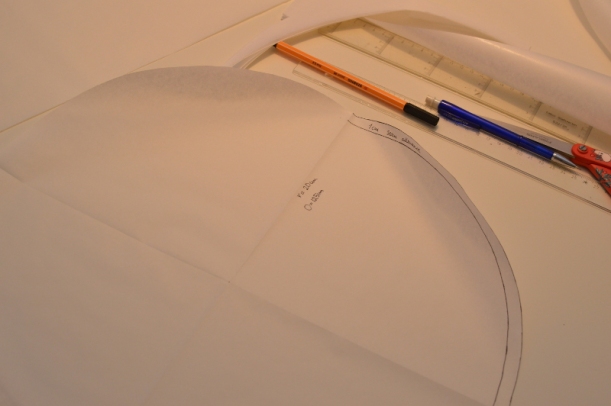As my life changes, so will the content on my blog. In my last blog post I told you that I’m about to become a mother so maybe it doesn’t come as a big surprise that from now on, you’ll see a bit of baby stuff here as well :). The first thing I decided to make for the baby was a changing pad that would fit the changing table we got from IKEA.
I got both the fabric and the foam base for the changing pad from a store called “Stoff & Stil”. The goal was to make a pad that would be easy to clean but still nice and cosy for the baby. With that in mind, I decided it would be a good idea to make two covers for the foam pad. The first cover would be made out of a pastel green oil cloth with some geometric shapes on it. Since oil cloth is water proof, this would be the “easy to clean layer”. For the second cover (that’s was supposed to go over the first one), I got a soft cotton satin with grey and yellow raindrops on it. I thought the yellow raindrops was quite befitting a changing pad :)
Stoff & Stil also had a pattern for the changing pad but since the shape of the thing was so simple, I didn’t really see the point in spending money on something I could make myself in 30min. To begin with, I measured the sides and made a pattern for that. After the sides were finished, I measured the circumference of the pattern and the length of the foam base. With those measurements I had a rectangle that would go around the pad. Last but not least, a 1cm seam allowance was added. When the pattern was done it was time to start pattern matching and cutting out the pieces. Because of the very symmetrical geometrical shapes on the oil cloth, this turned out to be a walk in the park! To make the sewing a bit easier, I used a pencil to draw where the seam should go on both side pieces.
Assembling the whole thing was a bit trickier than usual because you obviously can’t use pins on a plastic oil cloth. That would just leave ugly puncture marks all over the place. Instead, I got to use these handy little clips from Clover that I got from Okadaya in Tokyo. The first step was to attach the invisible zipper. I can highly recommend inserting the zipper as soon as possible. It’s just so much easier to attach it to a garment/cushion/etc. when the fabric lies flat. Next, I continued sewing around the side where the zipper was attached. One stretch at a time was “clipped” together and sewn. When reaching the corners, I had to cut the oil cloth in order to continue with the next stretch without the fabric bulging into weird shapes. The same procedure was repeated for the other side and last but not least, the side seam on the large rectangle was sewn.

Half of the zipper is in place.

“Clip” and sew one stretch at a time (red clips). The pink clip to the right just keeps the oil cloth in place.
Yay, the first cover was done! At this point I had no idea that I would spend the coming 15min sweating and cursing while I was wrestling the foam base into the cover. Have you ever touched and eel and gotten surprised at just how slippery it is? Well, that pretty much describes my experience with the foam, only that the foam was the exact opposite of slippery. After I won the wrestling match, I decided that I wouldn’t be making a second cover. There is just no way I’m putting a cover on/off of that changing pad on a regular basis. Instead, I’ll probably make something like a towel/blanket to put on top of the changing pad. That way it would still be nice and cosy for the baby and easy to remove and throw in the laundry.

The invisible zipper at the back is pretty invisible :)

The finished changing pad on top of the changing table!






 When sewing, always try to sew the “flat things” first which is why I started with the top hem of the sack. After that, sew the rectangle into a tube and attach the tube to the circle. This was one of the easier things I’ve made in a long time :)
When sewing, always try to sew the “flat things” first which is why I started with the top hem of the sack. After that, sew the rectangle into a tube and attach the tube to the circle. This was one of the easier things I’ve made in a long time :)















